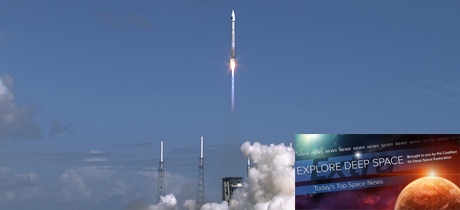In Today’s Deep Space Extra… Orbital ATK’s latest re-supply mission is on course to reach the International Space Station early Tuesday. NASA’s evolving role in the exploration of space moves to the orchestration of crucial advances.
Human Space Exploration
Antares rocket boosts cargo ship to orbit
Coalition Member in the News (Orbital ATK)
CBS News (11/12): An Orbital ATK Antares/Cygnus resupply mission to the International Space Station lifted off from NASA’s Wallops Island Flight Facility on Sunday at 7:19 a.m., EST. The capsule with its 7,400 pound cargo was on course to reach the six person Space Station Tuesday at 4:50 a.m., EST. Astronauts on the Station will grapple Cygnus using the Station’s Canadian robot arm. The delivery is the 8th for Orbital ATK under a NASA contract.
‘The space industry is changing’ and NASA must evolve, lead Administrator says
CNBC (11/10): NASA’s role in space exploration is evolving to one of orchestrating advances, much like a venture capital enterprise that selects promising technologies and then invests, according to Bill Gerstenmaier, NASA’s Associate Administrator for Human Exploration and Operations. Gerstenmaier spoke Friday at the New Worlds conference in Austin, Texas.
Opinion: Human space travel is critical for the future of humanity
Aviation Week (11/11): Space exploration is necessary for the protection of life and the planet Earth, writes H.E. Dr. Mohammed Al Ahbabi, Director General of the UAE Space Agency, in an op-ed.
Coalition Member in the News (Orbital ATK)
Washington Post (11/10): Orbital ATK’s Cygnus resupply capsule will play a new role when it berths to the International Space Station’s U.S. segment early Tuesday. Cygnus launched Sunday atop an Orbital Antares rocket from NASA’s Wallops Island Flight Facility in Virginia. While berthed for about a month, the pressurized capsule will provide extra volume for science activities. Eventually, Orbital ATK would like to link multiple Cygnus modules together and to other spacecraft to provide living and working volumes for astronauts on deep space missions.
Space Science
Leonid meteor shower 2017: When, where & how to see it this month
Space.com (11/10): The Leonids are an intense annual meteor shower that is to peak November 17 -18, or late Friday, early Saturday. The moon, meanwhile, is moving toward new moon status on November 18, handing the observation stage to the Leonids.
Other News
The Dream Chaser spacecraft has completed a successful free flight
Ars Technica (11/11): Sierra Nevada’s winged, reusable Dream Chaser carried out a successful approach and landing test at Edwards Air Force Base, California, on Saturday. The Dream Chaser is one of three spacecraft under contract to NASA for the launching and return of cargo to the International Space Station between 2019 and 2014. Though unpiloted, Dream Chaser is designed to return to Earth by landing on a runway.
World View’s commercial balloon business is taking off
Arizona Daily Star of Tucson (11/11): World View Enterprises reports a surprising interest in unmanned payloads for its high altitude commercial balloon missions. The company’s first stratospheric mission from Spaceport Tucson launched on October 1. “We sort of surprisingly have this amazing business of unmanned (flight) work, so we’re letting that be the driver and have the manned flight fall in after that,” said Taber MacCallum, World View co-founder and Chief Technology Officer.
Major Space Related Activities for the Week
Major space related activities for the week of November 12-18, 2017
Spacepolicyonline.com (11/12): Orbital ATK’s eighth NASA contracted Cygnus resupply capsule is on course to reach the International Space Station early Tuesday. Meanwhile, the NASA/NOAA Joint Polar Satellite System-1 advanced technology weather and climate studies satellite is to launch from Vandenberg Air Force Base, California, on Tuesday at 4:47 a.m., EST. SpaceX is to launch the secretive Zuma satellite built by Northrop Grumman from NASA’s Kennedy Space Center on Wednesday at 8 p.m., EST.

